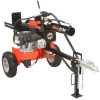Ariens 34-Ton Log Splitter Owners Manual - Page 18
HYDRAULIC OIL SYSTEM, Checking Hydraulic Oil Level, Recommended Hydraulic Oil
 |
View all Ariens 34-Ton Log Splitter manuals
Add to My Manuals
Save this manual to your list of manuals |
Page 18 highlights
HYDRAULIC OIL SYSTEM WARNING: HYDRAULIC FLUID can result in severe burns. Fluid in hydraulic system can penetrate skin and result in serious injury or death. Be sure to stop the engine and relieve hydraulic pressure before doing any work on hydraulic parts. Keep body and hands away from pin holes or nozzles which expel hydraulic fluid when under pressure. Use paper or cardboard, not hands, to search for leaks. Ensure all hydraulic fluid connections are tight and all hydraulic hoses and lines are in good condition before applying pressure to system. FOREIGN FLUID INJECTED INTO BODY can result in gangrene. Fluid must be surgically removed within a few hours by a doctor familiar with this form of injury. Checking Hydraulic Oil Level IMPORTANT: ADD OIL BEFORE OPERATING! Add hydraulic oil to operating level before use. Do not overfill. To check the hydraulic oil level: 1. Park the unit on a level surface. 2. Start the unit and run it to operating temperature (about 10 minutes). 3. Cycle the hydraulic cylinder in and out two or three times. 4. Shut off engine. 5. Remove any dirt that may be around the cap/breather on the hydraulic reservoir. 6. Remove cap/breather and wipe oil level dipstick clean. 7. Replace cap/breather and fully tighten. 8. Remove cap/breather and check oil level on dipstick. Oil should be within the operating range. See figure 16. Hydraulic Oil Reservoir Cap/Breather Hydraulic Oil Level Operating Range Figure 16 9. Add hydraulic oil as necessary. Do not overfill. Recommended Hydraulic Oil Only use the following hydraulic oils: • ISO32 hydraulic oil (Ariens part number 00069100) • Dexron® III/Mercon® automatic transmission fluid • 10 weight AW hydraulic oil • Pro-Mix™ AW-32 Hydraulic Oil Changing Hydraulic Oil and Filter NOTE: Change the hydraulic oil and oil filter every season or 100 hours. 1. Clean area around hydraulic supply hose. 2. Place container under oil filter and hydraulic supply hose to catch oil. 3. Remove hose clamp and disconnect hose from hydraulic tank. See figure 17. Hydraulic Tank Hydraulic Supply Hose Figure 17 4. Remove oil filter. 5. Allow tank to drain. 6. Reinstall hydraulic suction hose and tighten hose clamp. 7. Lubricate rubber gasket on new oil filter with clean hydraulic oil. GB - 18















